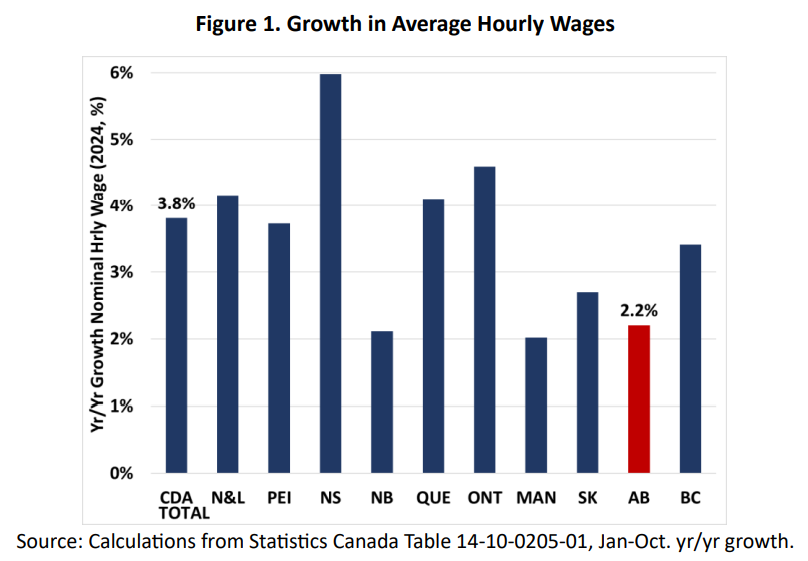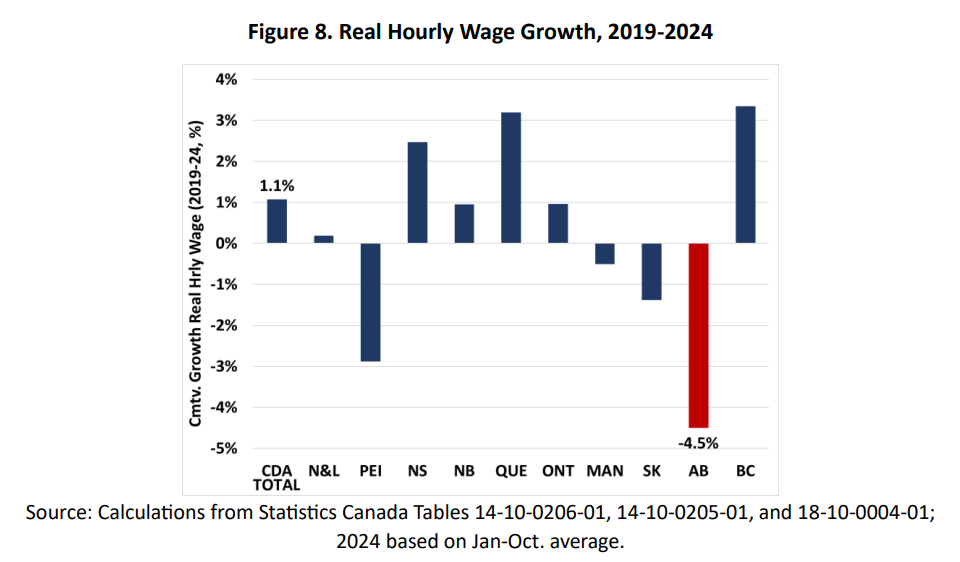
Average weekly earnings grew 3.5% year-over-year in first 10 months of 2024 – compared to 4.4% nationally

Alberta’s wages are falling behind the rest of Canada, despite the province having the highest gross domestic product per worker, according to a recent report.
That’s because the wage system in the province is designed to benefit employers, claims the Centre for Future Work.
“The universal nature of the decline in real incomes for Alberta workers further attests to the systemic and deliberate nature of wage-suppressing policies and practices,” says Jim Stanford, economist and director at the research institution, in the report.
“It doesn’t matter whether an industry is booming (as petroleum has been) or struggling. It doesn’t matter whether you are an hourly production worker or a salaried professional. The wage system in Alberta has been rigged to deliberately hold back wages, and transfer the resulting surplus to corporations and other employers. This is why living standards in Alberta are deteriorating.”
Wage inequality went down in about two-thirds of all countries since 2000, with the most significant decreases logged among low-income countries, according to a previous report from the International Labour Organization (ILO).
Alberta’s wage growth has been among the slowest in Canada, notes the Centre for Future Work. In 2024, average hourly wages increased by 2.2%, “barely half” of the national average of 3.8%.

“Average weekly earnings in Alberta grew 3.5% year-over-year in the first 10 months of 2024,” reads part of the report titled The Alberta Wage Disadvantage: Evidence on Alberta’s Continuing Suppression of Wages and Salaries.
“That is significantly slower than the Canadian average (4.4%), and also the third slowest of any province (ahead only of Newfoundland & Labrador and New Brunswick).”
Alberta also recorded the highest consumer price inflation among provinces in 2024 at 2.9%, above the national rate of 2.4%.
Also, real hourly wages in Alberta declined 4.5% over the last five years – falling almost 1% per year.
“That is far worse than the experience in other provinces, and continues a trend of falling real wages in Alberta that dates back to 2013,” says Stanford.
“In the rest of Canada, however, real wages have grown on a net basis, increasing 1.1% on average for the country as a whole. Real wage growth was strongest, over 3%, in Quebec and B.C. – which not coincidentally now rank as Canada’s wage leaders.”

Stanford also claims that the nominal and real minimum wage in Alberta has dropped 16.9% since 2019, with the hourly rate staying at $15 since 2019.
In 2024, average hourly wages in Alberta were just 2% higher than the Canadian average. Alberta’s previous wage advantage – which was as wide as 17% above the national average in 2013 – has mostly disappeared, notes Stanford.
In 2022, the median family after-tax income of Canadians was $60,800, up by 2.5% from 2021, before adjusting for inflation. However, when adjusted for an annual rate of inflation of 6.8%, the 2022 median family after-tax income was 4.0% lower than in 2021, according to a previous report from Statistics Canada (StatCan).
Now Stanford is calling for change in the province’s wage system: “The wage system must be repaired, and workers given the institutional and bargaining power to win back a fair share of the wealth they produce.”
He cites the following “obvious” remedies to the problem:
“These unacceptable trends are not a natural or inevitable result of economic forces. They are the intended result of deliberate policy choices. Albertans need their government to make different choices – to acknowledge that rising wages are a good thing, a sign of success, not a problem to be suppressed,” says Stanford.
“Alberta workers need a government that supports them in trying to win fair wages and protect their living standards, rather than holding them back.”
In October 2024, the Alberta Federation of Labour also called for the provincial government to increase the hourly minimum wage in the province.
“A wage freeze is a cut. If the Alberta minimum wage had kept pace with inflation over the past 6 years, it would be $19 per hour today. But, given the high cost of living in Alberta, even that would not be enough,” said AFL President Gil McGowan.
According to the group, the living wage for workers to cover their basic expenses and have a modest standard of living varies by community, and is above $20 per hour in many Alberta towns and cities, including about $24 per hour in Calgary and Fort McMurray; and $21-$22 per hour in Edmonton, Spruce Grove, St. Albert, Stony Plain, High River, Lac La Biche, and Lethbridge.
“Alberta used to be a wage leader, not anymore,” said McGowan. “Minimum-wage earners have lost almost 30% of their purchasing power because of the UCP wage freeze. All Alberta workers should earn enough to put food on their tables and keep a roof over their heads. But, as Albertans struggle to pay their bills, the UCP is missing in action.”
Previously, the City of Winnipeg Mayor’s Executive Policy Committee claimed that the city would have to spend more than $3 million more per year if it offered city workers a wage rate that some advocates consider a living wage.